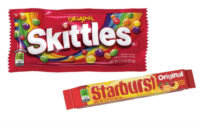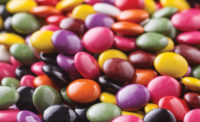The natural colors market can be a minefield. Regulations are unclear, consumers have a hard time following it, and finding vibrant colors can be difficult. Sandy Golden-Dukes, Director of Business Development, IFC Solutions, offers his advice on natural alternatives, the FDA, and the future of the sector.
Candy Industry: What are the latest color innovations from IFC Solution?
Golden-Dukes: Our Organics: With the introduction of our new Organic Spirulina Extract, we now have the capabilities to make great Blues, Greens, and Purples for our organic confectionery customers. It also allows us to make Caramel-Free Brown Blends for those of our customers who want to be Prop 65 compliant. We’ve always had a strong selection of Organic Colors, but these new options are really helpful for our customers who had previously be stuck with a lot of Organic Reds, Yellows and Oranges. All of our Organic Colors are available in Powder, Organic Glycerin, Organic Sucrose or Organic Vegetable Oils depending on our customers’ needs.
Our TiO2 Alternatives: While there is nothing as bright or as opaque as Titanium Dioxide on the market, recent marketing and legal changes in both the U.S. and Europe have our customers looking for alternatives. We have developed some great Natural and Organic Compliant White based Color Blends for confectionery products. We’ve also developed some wonderful White Ingredient Blends as well that are label friendly and considered some of the best substitutes our customers have seen. While none of these are 1:1 replacements, there has been a lot of growth in this space for us as we constantly work to get closer to a TiO2 match.
CI: How are things progressing in the natural colors market? Are there any new innovations in natural colors as far as vibrancy?
Golden-Dukes: In terms of our in-house innovations, we’ve spent the last two years developing Natural White Alternatives to TiO2. With each iteration, we’ve gotten closer and closer to achieving a brightness and opacity of TiO2. While we are still working on getting a match, it’s definitely been one of the most interesting and fast-paced R&D projects we worked on in some time.
For the industry as a whole, things are progressing as well. More ingredients are being approved as natural colorants and there are plenty of petitions to the FDA in the pipeline to add more. Hopefully, we’ll have more options to offer our customers in the years to come.
CI: How should companies decide whether they are going to use natural colors or artificial colors for a product? What are some things they should be aware of when making this decision?
Golden-Dukes: Like any ingredient, it depends on what kind of product you are looking to make and what audience you are looking to reach. Everyone knows that naturals (on average) are more expensive to use than artificial colors. So, natural colors seemed to be reserved for more “premium” products. This is especially true in the confectionery space where margins are tight as is with sugar prices in the U.S. But for consumers who are seeking Natural and Organic Foods, they’ll accept nothing less than a clean label product. I do want to give one word of caution from what we have seen in our 60 years in food color: most companies we’ve worked with that have tried to make the full switch from artificial colors to all natural have seen huge negative impacts in their business and sales. Just look what happened when General Mills made the switch with Trix and Lucky Charms back in 2017. We recommend to all of our customers to metaphorically dip their toes in the natural waters first before taking a full dip to avoid issues like that. Don’t just switch everything over. Start a second line instead and see how your customers respond. We’ll help you make that transition so that the colors your brand has come to rely on can carry over to a cleaner label option your customers will recognize and approve.
CI: Where do you see the colors market going in the next 5-10 years? Do you think more companies will be using natural colors? Do you see U.S. regulation banning most artificial colors ever happening?
Golden-Dukes: It’s hard to say without a crystal ball. Overall, the trend of natural colors and natural products in general is on the rise. While products with artificial colors still dominate the market place, I’d imagine we are not far off from them equaling out from a global demand stand point in the next 10 years. From what we know, the FDA has no plans of banning artificial colors. They do a good job of keeping an eye on studies and, so far, have not found any reason for banning the items on the current list. Same goes for the EU. The EU requires a warning label, but hasn’t found any reason to ban artificial colors either. So, I’d imagine they are safe for the near future. But, in terms of regulatory changes, what we do need is more natural ingredients being approved as colorants. While the list is growing, even when an item does pass FDA approval, it is often for limited applications. Calcium Carbonate is the most recent addition to join the list, but it is only allowed in soft and hard candy or in food grade inks. The rest of the food industry is still stuck with TiO2 as it’s only alternative for a white colorant. So, my hope would be that over the next 5-10 years, we start seeing new options available and more uses for the ones already approved.
CI: Anything else you would like to add?
Golden-Dukes: It should be clarified, that the FDA does not recognize the term “Natural Colors”. Those colors are technically called “Colors Exempt from FDA Batch Certification.” But, since that’s a mouthful, most people refer to them simply as “Natural”. But this is an important distinction when it comes to finished product labeling. I’ll walk the Fancy Food Show all the time and find companies labeling their products with “natural color” on the ingredient statement. That’s wrong and can possibly get you in trouble with the FDA. We take pride in educating our customers on this point so that there is no confusion when they use our products. We do the same thing when it comes to explaining the difference between an FDA Approved Colorant and an Ingredient. You’d be surprised about how many US based candy companies are using non-FDA approved Colorants because their supplier didn’t educate them on that.





